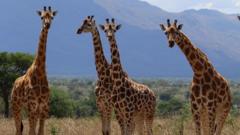The giraffe, an iconic emblem of the African savanna, has long been recognized as a single species, but recent analyses have revealed a more complex reality. Researchers at the International Union for Conservation of Nature (IUCN) have determined that there are indeed four genetically distinct species of giraffe, marking an important milestone for conservation efforts.
This latest classification arises from comprehensive examinations of skull size, head shape, and the genetic variances among various populations of giraffes spread across the African continent. The researchers took into account natural barriers such as rivers and mountain ranges that may have prompted these groups to evolve independently over time.
Among the newly recognized species is the Southern giraffe, which roams in countries including South Africa and Namibia. Genetic studies indicate that geographical divides such as the Kunene and Zambezi rivers have helped maintain its isolation from other giraffe populations.
In addition, the Reticulated giraffe has been identified as a separate species, found predominantly in Kenya and Somalia, where the Tana River and the region's mountainous terrain have effectively segregated it from its northern counterparts. The Northern giraffe inhabits parts of central and western Kenya as well as eastern South Sudan, with significant barriers such as Lake Victoria and the Nile River playing a role in its distinct lineage.
Lastly, the Masai giraffe, known for its beautiful, leaf-patterned coat, can be found across Kenya, Tanzania, and Uganda. Its close proximity to the Northern giraffe underscores the complexity of giraffe taxonomy, as features such as pattern vary significantly even within localized populations.
According to Michael Brown, a co-author of the report, this newfound genetic information is crucial for the conservation of these majestic beings. The IUCN will now reassess the conservation status of these four species, as understanding their taxonomy better positions conservationists to develop effective measures to support their populations.
This significant reclassification not only unveils the complexity of giraffe populations but also provides a pathway to ensuring the preservation of these extraordinary creatures that have captivated hearts around the world.
This latest classification arises from comprehensive examinations of skull size, head shape, and the genetic variances among various populations of giraffes spread across the African continent. The researchers took into account natural barriers such as rivers and mountain ranges that may have prompted these groups to evolve independently over time.
Among the newly recognized species is the Southern giraffe, which roams in countries including South Africa and Namibia. Genetic studies indicate that geographical divides such as the Kunene and Zambezi rivers have helped maintain its isolation from other giraffe populations.
In addition, the Reticulated giraffe has been identified as a separate species, found predominantly in Kenya and Somalia, where the Tana River and the region's mountainous terrain have effectively segregated it from its northern counterparts. The Northern giraffe inhabits parts of central and western Kenya as well as eastern South Sudan, with significant barriers such as Lake Victoria and the Nile River playing a role in its distinct lineage.
Lastly, the Masai giraffe, known for its beautiful, leaf-patterned coat, can be found across Kenya, Tanzania, and Uganda. Its close proximity to the Northern giraffe underscores the complexity of giraffe taxonomy, as features such as pattern vary significantly even within localized populations.
According to Michael Brown, a co-author of the report, this newfound genetic information is crucial for the conservation of these majestic beings. The IUCN will now reassess the conservation status of these four species, as understanding their taxonomy better positions conservationists to develop effective measures to support their populations.
This significant reclassification not only unveils the complexity of giraffe populations but also provides a pathway to ensuring the preservation of these extraordinary creatures that have captivated hearts around the world.























